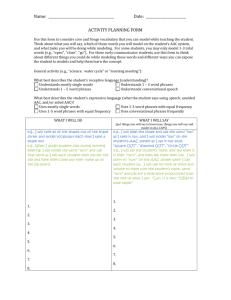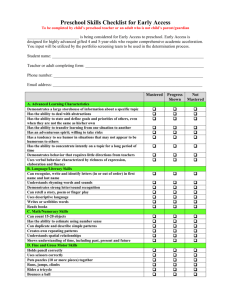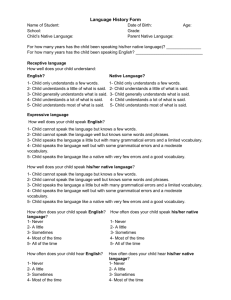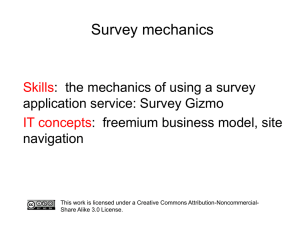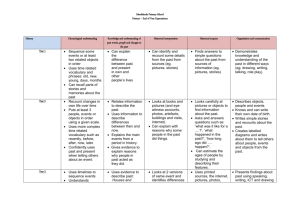Dynamic AAC Competency Goals - Pre
advertisement
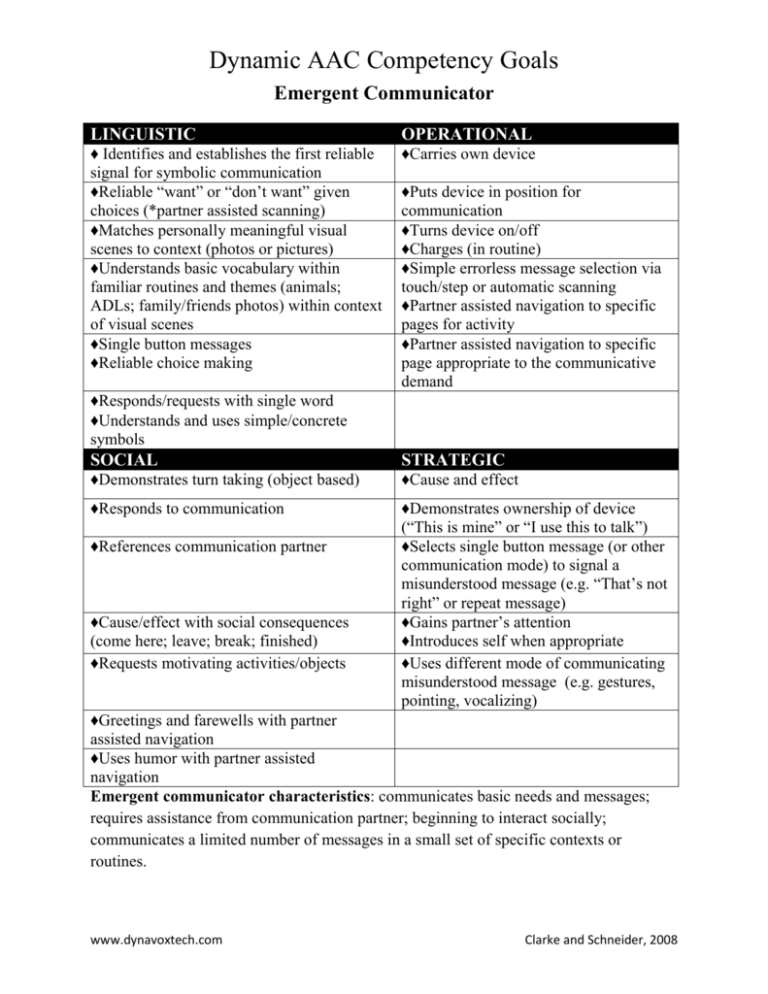
Dynamic AAC Competency Goals Emergent Communicator LINGUISTIC OPERATIONAL ♦ Identifies and establishes the first reliable signal for symbolic communication ♦Reliable “want” or “don’t want” given choices (*partner assisted scanning) ♦Matches personally meaningful visual scenes to context (photos or pictures) ♦Understands basic vocabulary within familiar routines and themes (animals; ADLs; family/friends photos) within context of visual scenes ♦Single button messages ♦Reliable choice making ♦Carries own device ♦Puts device in position for communication ♦Turns device on/off ♦Charges (in routine) ♦Simple errorless message selection via touch/step or automatic scanning ♦Partner assisted navigation to specific pages for activity ♦Partner assisted navigation to specific page appropriate to the communicative demand ♦Responds/requests with single word ♦Understands and uses simple/concrete symbols SOCIAL STRATEGIC ♦Demonstrates turn taking (object based) ♦Cause and effect ♦Responds to communication ♦Demonstrates ownership of device (“This is mine” or “I use this to talk”) ♦Selects single button message (or other communication mode) to signal a misunderstood message (e.g. “That’s not right” or repeat message) ♦Gains partner’s attention ♦Introduces self when appropriate ♦Uses different mode of communicating misunderstood message (e.g. gestures, pointing, vocalizing) ♦References communication partner ♦Cause/effect with social consequences (come here; leave; break; finished) ♦Requests motivating activities/objects ♦Greetings and farewells with partner assisted navigation ♦Uses humor with partner assisted navigation Emergent communicator characteristics: communicates basic needs and messages; requires assistance from communication partner; beginning to interact socially; communicates a limited number of messages in a small set of specific contexts or routines. www.dynavoxtech.com Clarke and Schneider, 2008 Dynamic AAC Competency Goals Context Dependent LINGUISTIC OPERATIONAL ♦Understands and uses themes / levels / contexts ♦Operational device management with onscreen sequences: ex: soft reset, volume control, voice controls ♦Participates in programming (symbol and message selection with choice) ♦Retrieves device ♦Asks for assistance when problem arises ♦Touching/Scanning to select meaningful choices with distracters present (avoids blank buttons) ♦Touch/switch activation to select “correct” or “logical” choices within the context of the event/discussion/activity ♦Selects page back button with consistent location on all pages ♦Selects linking pages with action symbols ♦Selects linking pages with category symbols ♦Selects linking pages with location cues (ex: scene based pages or row / column scanning) ♦Understands and uses symbols to reference time (“today/tomorrow”) ♦Tells or retells a story ♦Indicates “more than one” ♦Understands and uses abstracts symbols (verbs and concepts: quantitative /qualitative/spatial) ♦Begins to combine 2-3 word messages ♦Recognizes letter/sound associations ♦Matches visual scenes to context ♦Uses short, quick, multifunctional messages to maintain/ control/ comment as appropriate to conversation (“Cool”, “Hang on”, “That stinks”, etc.) ♦Understands and uses descriptive words to clarify nouns (adjectives) ♦Navigates and uses word-based pages for intended message SOCIAL STRATEGIC ♦Maintains eye contact ♦Initiates conversations with partner assisted navigation to preprogrammed pages ♦Selects from 1 or more messages to prevent communication breakdown (e.g. delivers descriptive instructions on how to communicate with him/her). ♦Selects from 2 or more messages to signal a misunderstood message (e.g. “Wrong, try again” or “Let me tell you another way”) ♦After signaling misunderstanding, utilizes 1 or more strategies to repair misunderstanding. ♦ Repeats all/part of message ♦ Changes speech output (volume and/or rate) ♦ Expands intended message ♦Demonstrates turn-taking (Social/Activity Based) ♦Maintains topic ♦Terminates conversation with partner assisted navigation to preprogrammed pages ♦Shares several pieces of preprogrammed “news” or information on an activity board ♦Spontaneously greets and says farewell with navigation ♦Uses humor ♦Requests information ♦Requests actions ♦Asks partner focused questions ♦Shifts topics smoothly with suggestions Context dependent communicator characteristics: limited literacy skills; overall ability to communicate dependent on environment, topic, or partner; understands most concrete symbols, some abstract; limited ability to combine symbols to create new messages. www.dynavoxtech.com Clarke and Schneider, 2008 Dynamic AAC Competency Goals Independent Communicator LINGUISTIC OPERATIONAL ♦Understands and uses morphological endings to denote time concepts (past “-d”, present “-ing”) ♦Page navigation ♦Uses plural “s” to denote “more than one” ♦Uses existing vocabulary to describe new word or concept not in device ♦Produces messages with increased length and/or complexity (e.g. different sentence forms, questions, flexibility in message choice) ♦Understands and uses morphological endings to qualify verbs (er /ly) ♦Takes care of AAC device and components ♦Increased independence in programming (accesses programming menus) ♦Increased access to external devices (phone, printer, email, IR controls) ♦Stores files, customized messages, and sequences ♦Row/Column/Group Scanning with purposeful selection of “correct” or “logical” choices ♦Demonstrates independent spelling skills at age level, with or without word prediction SOCIAL STRATEGIC ♦Demonstrates turn-taking ♦Chooses appropriate message or strategy to prevent a communication breakdown ♦Requests clarification ♦Uses social language (verbal or non-verbal fillers) ♦Uses gesture/message to indicate intent of using a “first letter” strategy, then provides first letter of word for listener to guess ♦Uses polite social forms ♦Chooses appropriate message / strategy to signal a communication breakdown ♦Changes message to ensure listener ♦Signals a topic change with appropriate understands. message ♦Initiates conversation using standard page ♦Uses appropriate rate enhancement strategy sets and navigation (e.g. telegraphic message; abbreviated/shortened words; uses number or single letter 4=“for”) ♦Terminates conversation using standard page ♦Uses appropriate “start over” strategy when sets and navigation message becomes lost through too many attempts to repair. ♦Uses partner focused questioning to continue conversation. Shifts topics smoothly with segues. Independent communicator characteristics: age appropriate receptive language; follows linguistic rules appropriate for age; socially engaged; writes and spells near age level; combines single words, spelling and phrases to create novel messages about variety of subjects. www.dynavoxtech.com Clarke and Schneider, 2008
